

Basics - Mobile Learning Handbook. Student Polling/Audience Response Systems This topic deserves a special section because its use is becoming more common, and the use cases can be compelling for instructors of synchronous learning experiences.
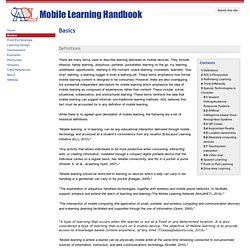
This mobile device application involves presenting a question to students through their learning medium (e.g., PowerPoint slides in a classroom). Students are asked by the instructor to send a text message to a designated address, with key codes corresponding to poll answer choices. The results are displayed immediately on the learning medium. This can be used by the instructor during a class to assess whether students understand a concept, to characterize the demographics of his/her audience in order to fine tune the delivery, or just to gauge how prevalent certain (possibly erroneous) assumptions or motivations are about the content in advance. Artificial Intelligence-based Voice Recognition Systems This has changed dramatically with the advent of Siri on the iPhone.
A pedagogical framework for mobile learning: Categorizing educational applications of mobile technologies into four types. Yeonjeong Park Virginia Tech, USA Abstract Instructional designers and educators recognize the potential of mobile technologies as a learning tool for students and have incorporated them into the distance learning environment.
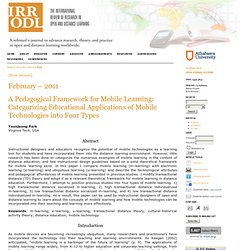
However, little research has been done to categorize the numerous examples of mobile learning in the context of distance education, and few instructional design guidelines based on a solid theoretical framework for mobile learning exist. Researchrepository.murdoch.edu.au/5413/1/authentic_mobile_learning.pdf. Www.mobilearn.org/download/results/guidelines.pdf. Unesdoc.unesco.org/images/0021/002169/216910f. College Quarterly - Reviews - A New Culture of Learning: Cultivating the Imagination for a World of Constant Change.
College Quarterly Summer 2012 - Volume 15 Number 3 A New Culture of Learning: Cultivating the Imagination for a World of Constant Change Douglas Thomas and John Seely Brown Lexington, KY: Douglas Thomas and John Seely Brown, 2011 Reviewed by Cecilia Aponte-de-Hanna Thomas and Brown have joined forces to share their extensive knowledge in the field of communication, culture, and digital learning environments.
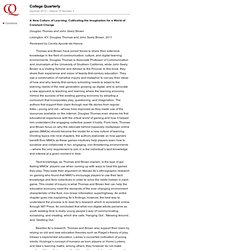
Tacit knowledge, as Thomas and Brown explain, is the type of gut feeling MMOs’ players use when coming up with ways to beat the games they play. To me, this idea of learning in the twenty-first century definitely gives a new meaning to Bob Dylan’s phrase ‘The times they are a changing’ because, in the new culture of learning, time changes while culture adapts. Overall, this book does provide an excellent introduction to most twenty-first-century learning theories. AJET 27(8) Lai (2011) - Digital technology and the culture of teaching and learning in higher education. Digital technology and the culture of teaching and learning in higher education Kwok-Wing LaiUniversity of Otago This paper discusses how the use of digital technologies may support a shift of cultural practices in teaching and learning, to better meet the needs of 21st century higher education learners.
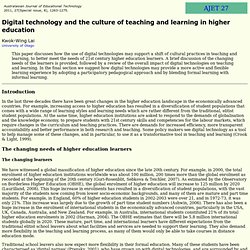
A brief discussion of the changing needs of the learners is provided, followed by a review of the overall impact of digital technologies on teaching and learning. In the final section we suggest how digital technologies may provide a more active and flexible learning experience by adopting a participatory pedagogical approach and by blending formal learning with informal learning. Introduction In the last three decades there have been great changes in the higher education landscape in the economically advanced countries. The changing needs of higher education learners The changing learners. Eprints.qut.edu.au/5399/1/5399. elearningresearch.middlesex.wikispaces.net/file/view/MJET%20vol%202%20December%202012.pdf/392312946/MJET%20vol%202%20December%202012.pdf#page=6.
iPadagogy: appropriating the iPad within pedagogical contexts - International Journal of Mobile Learning and Organisation - Volume 7, Number 1/2013. Journal Article Authors Thomas Cochrane1, Vickel Narayan2, James Oldfield3 1Centre for Learning And Teaching, AUT University, Auckland, New Zealand2Te Puna Ako, Unitec, Auckland, New Zealand3Department of Accounting and Finance, Unitec, Auckland, New Zealand.
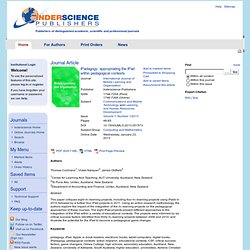
byodsandpit.weebly.com/uploads/1/1/3/0/11303946/litrev_2013_final_2.pdf. BYOD. From EdFutures Models of ICT provision | Desktop provision | Mobile loan | 1:1 | BYOD | BYOT Bring Your Own Device (BYOD) refers learners being able bring any mobile computing device in to school and connect it to the school network, so long as they have registered the device in advance with the school.
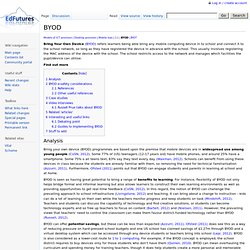
This usually involves registering the MAC address of the device with the school. The school restricts access to the network and manages which facilities the pupil/device can utilise. Find out more Analysis BYOD e-safety considerations Recent news articles strongly suggested that by banning students from bringing in their mobile phones, schools can dramatically reduce cyberbullying and raise pupil attainment. It has long been known that online behaviour tends to mirror offline behaviour, and that those pupils most at risk of abuse in the physical world tend to be so in the virtual world as well (UNESCO 2012). www.ruor.uottawa.ca/fr/bitstream/handle/10393/24274/Hogue_Rebecca_2013_Considerations_for_a_Professional_Development_Program.pdf?sequence=1. Bibliography. Bibliography The following bibliography represents many of the books and articles written on mobile learning in the past decade, especially those on mobile learning for adults.

Many of the articles and conference papers can be easily found by entering the title into a search engine. Www.unesco.org/new/fileadmin/MULTIMEDIA/HQ/ED/ICT/pdf/UNESCO MLW report final 19jan.pdf. Réseau social. Un article de Wiki Paris Descartes.
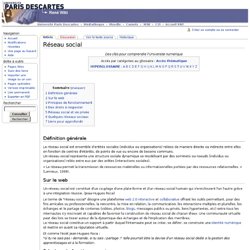
Des clés pour comprendre l'Université numérique. Benhur.teluq.uquebec.ca/SPIP/inf9013/IMG/pdf/M2_reseauApprend.pdf. Les vidéos d’exemples de pratique pour susciter le changement. 1Comme de nombreux pays, le Québec s’est engagé, depuis le début des années 2000, dans une réforme de l’éducation qui se caractérise par une refonte des programmes de formation des jeunes Québécois (Gouvernement du Québec, 2001).
Cette réforme est le fruit d’un vaste processus de consultation sur l’état de l’éducation au Québec. Australasian Journal of Educational Technology. The Australasian Journal of Educational Technology is the journal of ascilite, the Australasian Society for Computers in Learning in Tertiary Education.
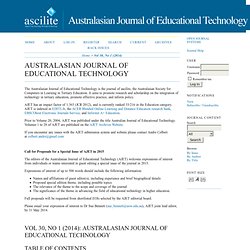
It aims to promote research and scholarship on the integration of technology in tertiary education, promote effective practice, and inform policy. AJET has an impact factor of 1.363 (JCR 2012), and is currently ranked 33/216 in the Education category. AJET is indexed in EDITLib, the ACER Blended Online Learning and Distance Education research bank, EBSCOhost Electronic Journals Service, and Informit A+ Education. Prior to Volume 20, 2004, AJET was published under the title Australian Journal of Educational Technology.
Hypomnematon – Rapport sur la modernisation de l’enseignement supérieur. Dans mes lectures du moment, il y a le rapport du groupe d’experts de haut niveau sur la modernisation de l’enseignement supérieur.
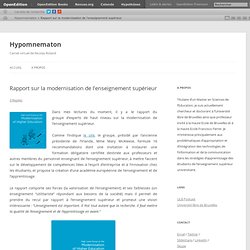
Comme l’indique le site, le groupe, présidé par l’ancienne présidente de l’Irlande, Mme Mary McAleese, formule 16 recommandations dont une invitation à instaurer une formation obligatoire certifiée destinée aux professeurs et autres membres du personnel enseignant de l’enseignement supérieur, à mettre l’accent sur le développement de compétences liées à l’esprit d’entreprise et à l’innovation chez les étudiants, et propose la création d’une académie européenne de l’enseignement et de l’apprentissage.
Pratique.pdf. Www.ruor.uottawa.ca/fr/bitstream/handle/10393/24274/Hogue_Rebecca_2013_Considerations_for_a_Professional_Development_Program.pdf?sequence=1. Les vidéos d’exemples de pratique pour susciter le changement. Www.unow.fr/assets/files/livre_blanc_MOOC_Design_UNOW.pdf. Www.cdc.qc.ca/pdf/787143_ouellette_classe_en_reseau_MA_ulaval_2005.pdf. Créé par Camtasia Studio 7. Faculté des études supérieures et postdoctorales - Présentation matérielle. Règles générales Le mémoire ou la thèse peut être présenté sur différents supports, comme le précise le Règlement des études aux articles 153 et 156.
Sa présentation matérielle doit respecter un ensemble de règles qui sont communes à toutes les situations. Outre ces règles, des consignes propres au domaine d'études peuvent exister. Les écarts aux règles de présentation établies doivent être approuvés par la Faculté des études supérieures et postdoctorales, sauf pour les exceptions du type prévu par l'article 147 du Règlement des études, notamment en musique et en arts visuels (les étudiants des programmes concernés peuvent obtenir de l'information auprès de leur direction de programme).
Www.european-mediaculture.org/fileadmin/bibliothek/francais/lebrun_courants/lebrun_courants.pdf. Intégrer NTIC mai 96. CHAPITRE 2 : LES CADRES ÉPISTÉMOLOGIQUE, THÉORIQUE ET CONCEPTUEL.
Pourquoi utiliser les médias sociaux au CÉGEP. Le Web 3.0 : état des lieux et perspectives d'avenir. A History of Silicon Valley. 33. The Sharks: the iPhone, Cloud Computing, Location-based Services, Social Games, & Personal Genomics (2007-10) by Piero Scaruffi THESE ARE EXCERPTS FROM THE BOOK A History of Silicon Valley The Decline of the Computer The late 2000s were the age of streaming media, smart phones, and cloud computing; all trends pointed towards the demise of the “computer” as it had been known for 50 years.
Music and file sharing were at the bleeding edge. As images, music, and videos proliferated (at increasingly higher resolutions), the demand for storage became prohibitive. Smart phones that allowed browsing the Web and exchanging e-mail had become very popular, notably the BlackBerry and the Razr, but the brutally competitive field was not for the faint of heart. The Cost of Formal and Informal Learning.
I'm sure most of you have come across a chart similar as the one shown below (chart 1) in which we are shown that 20% of the learning is formal and 80% is informal, yet paradoxical we spend 80% of our training budget on the formal and only 20% on the informal (Cross, 2007): Chart 1 The trouble with this chart is that while the percentage of learning is basically correct (see The Hype of Learning for more on this), the amount we spend on each is based on weak research, with much of that research simply “pulled out of thin air” (Cross, 2007).
Even if all the numbers are correct, it does not matter what the Learning department spends, but rather what the organization spends. Characteristics of Formal and Informal Learning. Allen Tough, a Professor Emeritus at the University of Toronto, focused his research on the adult's successful efforts to learn and change; and in particular the 70% that are self-guided without relying much on professionals or institutions (informal learning). During his research, he discovered that people spend an average of 15 hours per week learning on their own (Tough, 1999). In the late 1970s, Patrick Penland, a library school professor at the University of Pittsburgh, became quite interested in Tough's research. He performed a survey in which a section of it pertains to why learners prefer to learn on their own, rather than in a class or course (Penland, 1977). The main reasons, in ranking order, are: Formal and Informal Learning.
Malcolm Knowles is generally considered to have first coined the term informal learning through his book published in 1950, Informal Adult Education: A Guide for Administrators, Leaders, and Teachers. Allen Tough (1971) was probably the first person to really study how adults use informal learning through his work at the Ontario Institute for Studies in Education. The next big proponent of informal learning is probably Jay Cross (2007) who has wrote about it extensively through his blog and book Informal, Formal, and Nonformal Learning The terms formal and informal learning have nothing to do with the formality of the learning, but rather with the direction of who controls the learning objectives and goals.
In a formal learning environment the training or learning department sets the goals and objectives, while informal learning means the learner sets the goals and objective (Cofer, 2000). Bersin & Associates: Research and Advisory Services in Enterprise Learning & Talent Management. Le fin mot : MOOC: Service de soutien à la formation. Données probantes en éducation : pour en finir avec l'évaluation formative Bien que les avancées scientifiques sur l'évaluation soient nombreuses, «la coutume tient lieu de compétence» (Romainville 2006) et les avancées ne percolent que très peu dans la pratique. 00129384, version 1] Du réseau à la communauté d'apprenants. Quelle dynamique du lien social pour "faire oeuvre" sur Internet ?
Www.cdc.qc.ca/parea/RapportPAREAPoellhuberChomienne0306Final.pdf. Communauté d'apprentissage. Un article de Wiki Paris Descartes. The iPad as a Tool For Education - a case study. In the first two terms of implementing an iPad programme, Longfield Academy in Kent have noticed a great impact on teaching and learning. Research carried out on behalf of Naace and supported by 9ine consulting is published here. It’s really exciting to be able to announce our research into the use of iPads. After a successful implementation at Longfield Academy in Kent and two terms of embedded use, the research shows some incredibly positive impacts on teaching and learning.
The report on the research, carried out on behalf of Naace and supported by 9ine Consulting is available below. It outlines the conclusions of one of the most extensive studies so far undertaken into the use of tablets for learning. Please note: the tablet implementation surveys here include the questions used in this research. Any further queries can be directed via office@naace.co.uk The iPad as a Tool For Education - a case study.
iPad Education. Tablettes tactiles - Les tablettes tactiles. À ce jour, l'introduction des tablettes tactiles dans l'écosystème scolaire a rendu possible la mise en place de nouvelles pratiques pédagogiques qui développent des modalités d'apprentissage plus collaboratives et permettent un meilleur accompagnement des élèves. L'apport du Web 2.0 à la solidarite numerique - Destiny TCHEHOUALI. Sondages iPad. Biblio intéressante et complète. Réseaux sociaux et Apprentissage des langues - FLE KALEIDOSBLOG. Biblio intéressante - essai.